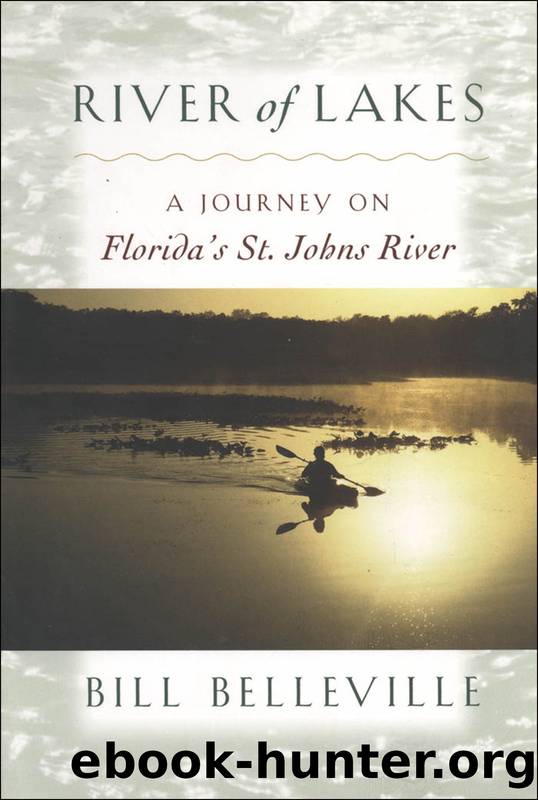River of Lakes by Belleville Bill;

Author:Belleville, Bill;
Language: eng
Format: epub
ISBN: 1441671
Publisher: University of Georgia Press
Published: 2001-01-01T00:00:00+00:00
6 Juniper Springs to Croaker Hole
The sluggish flow of the river tends to encourage and maintain wetland habitats throughout its length, thus preserving the natural appearance of much of the river corridor.âFrom the stateâs âFlorida Rivers Assessmentâ report of 1989
Of the ânotable mineral springsâ Sidney Lanier once reported along the river in his guidebook, the three most powerful emerge from the hilly karst terrain of the Ocala National Forest. They seem spaced, territorially, along the western shore, each with its own hydrological fiefdom: Juniper to the south, Silver Glen in the middle, and Salt to the north. Geologically, all arise from the limestone and dolomite of the Ocala Uplift, sedimentary bits of sand and coral and shell laid down as sea bottom in the Eocene some forty million to fifty million years ago.
Juniper is a thin, enchanting scribble of a clear creek fed not just by its namesake but by other spring boils along its run, including Fern Hammock and Sweetwater. It is a canoeable place, a narrow respite from the overwhelming largeness of Lake George. Salt, ensconced at the end of a shallow five-mile run through a lush green corridor, arises from four separate vents inside a limestone basin. Although owners of larger boats complain that the outflowing run is too shallow for them, it is precisely this shallowness that keeps the shoreline of the creek as undisturbed as it is. Eagles nest here above, bluegill below, the fish scalloping out rounded underwater beds from the sand with their tails.
Salt Springs is aptly named: ancient, deeply embedded veins of connate seawater hot-wire the chloride content of its outflow, at a rate much higher than any other spring in the region. Compared with Juniper, Salt carries four hundred times the dosage of chloride; in contrast to Silver Glen, three times. There are no âsalt bedsâ the water passes through to make this so, as is popularly believed. Rather, its brackishness is the result of relic seawater entering the aquifer in distant geological time, when Florida was nearly covered by the ocean. It is no wonder that a submerged marine grass (Haisa marina) found nowhere else along the freshwater river grows here in profusion, no wonder that a four-foot-long blacktip shark was recently spotted, swimming upstream, in the run of Salt.
In Bartramâs time, the force of the upwelling at Salt was so strong that it was described as âa continual and amazing ebullition where the waters are thrown up in such abundance and amazing force as to jet and swell up to two or three feet above the common surface.â Today the surface is nearly flat, showing only ripples of a mild boil. Perhaps well pumping in the fast-growing city of Ocala to the far west has increased at the same time recharge areas have declined. There is simply less ibi to be had, a sign of finite hydrological power defused.
The 625-square-mile national forest here surrounds the most extensive scrub environment in the world, one marked by sand hills and rolling scrub communities, covered mostly with sand pine and the stunted Chapman and myrtle oaks.
Download
This site does not store any files on its server. We only index and link to content provided by other sites. Please contact the content providers to delete copyright contents if any and email us, we'll remove relevant links or contents immediately.
Man-made Catastrophes and Risk Information Concealment by Dmitry Chernov & Didier Sornette(5643)
The Revenge of Geography: What the Map Tells Us About Coming Conflicts and the Battle Against Fate by Kaplan Robert D(3960)
Zero Waste Home by Bea Johnson(3652)
In a Sunburned Country by Bill Bryson(3361)
COSMOS by Carl Sagan(3346)
Good by S. Walden(3343)
The Fate of Rome: Climate, Disease, and the End of an Empire (The Princeton History of the Ancient World) by Kyle Harper(2865)
Camino Island by John Grisham(2716)
A Wilder Time by William E. Glassley(2686)
Organic Mushroom Farming and Mycoremediation by Tradd Cotter(2563)
The Ogre by Doug Scott(2500)
Human Dynamics Research in Smart and Connected Communities by Shih-Lung Shaw & Daniel Sui(2431)
Energy Myths and Realities by Vaclav Smil(2377)
The Traveler's Gift by Andy Andrews(2297)
9781803241661-PYTHON FOR ARCGIS PRO by Unknown(2268)
Inside the Middle East by Avi Melamed(2230)
Birds of New Guinea by Pratt Thane K.; Beehler Bruce M.; Anderton John C(2175)
A History of Warfare by John Keegan(2099)
Ultimate Navigation Manual by Lyle Brotherton(2047)
